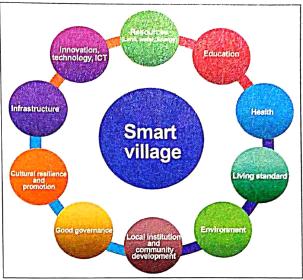

- According to the 2011 census of India, 68.84 percent of Indians (around 833.1 million people) live in 640,867 villages.
- Rural economy contributes half of the manufacturing, one-third of the services sector and the complete agricultural sector. The vision of New India 2022, an India free from poverty and corruption rests largely on the growth and development of rural India.
- Smart village could be an effective strategy for creating a strong, sustainable and self-reliant rural economy. It matches well the underlying thinking of the Central Government's AatmaNirbhar campaign and 'Vocal for Local'.
- There are many central government schemes implemented by various ministries such as Unnat Bharat Abhiyan(UBA), Pradhan MantriAdarsh Gram Yojana, Shyama Prasad MukherjiRurban Mission (SPMRM) and the SansadAdarsh Gram Yojana (SAGY) with an aim to bring transformative changes in our villages.
- In the scheme, Pradhan MantriAdarsh Gram Yojana(PMAGY), an 'Adarsh Gram' is defined as one wherein people have access to various basic services so that the minimum needs of all the sections of the society are fully met and disparities are reduced to a minimum.
- Smart village initiatives envisage holistic and integrated development of villages on multiple areas, health, education, livelihood and community development and so on. It also envisages, bundle of services delivered to its residents through community participatory approach in an effective and efficient manner.
- In addition, transfer of funds under 15th Finance Commission, State Finance Commission (SFC) and own source revenues provide opportunities to carry out various initiatives to convert villages into model or Smart villages.
- There is a need to have a close assessment of the existing smart village models with a focus on infrastructure creation, introduction of Internet of things (lOT) and use of ICT and IT-enable services.
- It is necessary to promote development of rural areas in tune with Gandhian vision of self-sufficient 'village republics', based on local resources and using decentralized , eco-friendly technologies so that the basic needs of food, clothing, shelter, sanitation, health care, energy, livelihood, transportation, and education are locally met and the goal of faster and inclusive growth is realised.
Good Cases of Smart Village:
- Mawlynnong (Meghalaya-Asia's cleanest village); RaleganSiddhi and Hiware Bazar (Maharashtra environmental conservation and irrigation system and water conservation program); Anandwadi, (Maharashtra-gender equality, the nameplates outside the houses proudly display the name of the woman in ownership of the house); Hazipalli Gram Panchayat(Telengana-ODF, Solid Waste Management, underground drainages and zero mosquitos) and others.
- It is important to study and document these good cases and draw lessons and use those to leverage and replicate in other parts of country with necessary customisation and tweaking, if any.
Framework and Analysis of Smart Village
- It is important to draw a strategy for preparing a holistic framework of a self-sustainable and viable model of smart village and also develop a measurable and monitorable set of indicators to grade our villages or panchayats and an executable plan within the existing rural institutional framework.
- The framework must take into account various factors including socio-economic and infrastructure development, conservation of natural resources, environment, preservation of socio-cultural fabrics of the villages and the technology that can enable holistic development of villages.
- The Sustainable Development Goals (SGDs) must be placed in the heart of social and economic transformation of villages.
- The skill mapping exercises of the reverse migrants initiated in many states including Uttar Pradesh, Jharkhand, Odisha, and Chhattisgarh is a welcome move.
- Access to shared services, Common Facility Centres, Cluster Development Programmes, Farmer Producers Organization (FPO), Producers Companies are going to make perceptible impacts on micro and small enterprises and SHGs operating in rural areas to scale up and generate employment for the local people.
- The contemporary situation demands for a transformation of subsistence agriculture into a diversified farming business and this process of transformation can be driven by youth.
- To attract youth into agriculture, it has to be transformed into a vibrant and tech-savvy sector by introducing robotics, ICT and nanotechnology. Agro-entrepreneurship, food processing and value development will also encourage youth into agriculture.
- Digital enablement is a crucial ingredient of smart village.
- The concept of smart village needs to be mainstreamed in the Gram Panchayat Development Plan (GPDP) and the whole process needs to be captured in it.
- Efforts should also be explored to leverage public-private partnership and volunteerism. But convergence of and synergy of all Government initiatives and their successful implementation will be crucial to convert are village in to smart village.
- Customised schemes should be designed for women, youth and underserved communities such as Scheduled Castes (SCs) and Scheduled Tribes (STs).
- Smart village should focus less on technology alone, and more on people, processes and institutions.
- To revive, rebuild and reconstruct the rural economy especially after the outbreak of COVID19 pandemic, smart village initiatives could be an effective strategy. It is time to reach out to each and every village and start a fresh conversation on smart village for realising an inclusive, sustainable and self-reliant India.
Related Articles


